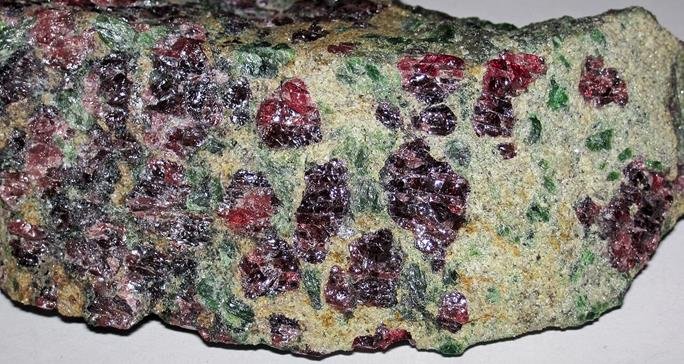Ultramafic is a common term in geology, GEOsciences, Earth sciences, or geography. It is commonly used in igneous rocks, their magmas, lavas, and some metamorphosized igneous rocks.
Metamorphosized rocks have transformed their mineralogy and structure or texture in response to a change in pressure, temperature, or chemically active fluids.
This change happens while the rock remains in solid form. Some can retain their original unmetamorphosed parent rock (protolith) texture.
What does ultramafic mean, and what are some rock examples and magma or lava characteristics?

What does ultramafic mean?
Ultramafic rocks, lava, or magma have 1) less than 45% silica, 2) greater than 18% magnesium oxide, and 3) high in iron oxides. Also, they have more than 90% mafic minerals, a high magnesium-to-iron, and are low in felsic minerals.
Mafic minerals are dark-colored rock-forming silicate minerals rich in iron and magnesium.
Silicates are abundant rock-forming minerals with silicate groups. Silicate groups have silicon and oxygen forming a tetrahedron structure where silicon is surrounded by four oxygen atoms, i.e., SiO44-.
Examples of mafic minerals are olivine, amphibole, pyroxene, and mica.
On the other hand, felsic minerals are rock-forming silicates high in elements of silicon, oxygen, aluminum, sodium, or potassium.
Felsic minerals include feldspars, quartz (tridymite or cristobalite), muscovite, feldspathoids, and corundum.
Note: Ultramafic isn’t an official IUGS (International Union of Geological Sciences). However, it will help you in the field to quickly group rocks.
Characteristic of ultramafic magma or lavas
Ultramafic magmas or lavas are uncommon. Most formed during the Archean age when the Earth was warmer. They probably formed from a high level of partial melting inside the mantle at higher temperatures.
For instance, komatiites probably formed at very high temperatures (more than 1600°C or 2912°F), at a higher level of partial melting of over 50%. This resulted in higher magnesium oxide and lower potassium oxide than basaltic magmas from only slight melting in the mantle.
Characteristics of these magmas include being denser due to the high content of dense elements and minerals like magnesium and iron.
Also, they erupted at high temperatures and were highly fluid. For instance, komatiites are thought to have erupted at 1600°C with a viscosity of 100 to 1000 cP (0.1 to 1 Pa⋅s) that compares to that of motor oil.
Viscosity is the measure of resistance to flow. It is higher in silica-rich, colder magma as the silica polymerizes and lower in hotter, low silica magma.
Lastly, although ultramafic rocks form in layered mafic intrusions, they form as cumulates, not directly from magma. Therefore, their chemistry doesn’t represent that of ultramafic magmas.
Ultramafic rock characteristics
Ultramafic rocks are dense, with typical densities of 3.1-3.4g/cm3, and darker in color with a typical color index M >90.
Their typical colors are greenish, dark gray, brownish-gray, reddish, or nearly black. However, the exact color of a given specimen will depend on the minerals present.
These rocks are ultrabasic, with some ultrapotassic. Ultrabasic means they have less than 45 wt. % silica. It doesn’t consider mafic mineral content.
On the other hand, ultrapotassic means they are high in potassium oxide compared to magnesium oxide, with K2O to MgO > 3.
Lastly, their composition is almost entirely made up of mafic minerals like pyroxenes and olivine. However, they have minor amphibole, mica, garden, spinel, and opaque oxides.
Where are they found?
Ultramafic rocks dominate the upper mantle, especially the peridotites. Also, they occur as cumulate rocks in layered mafic intrusions.
Other places where they occur include layers of ophiolites or xenoliths in mafic magmas, such as basalts. Ophiolite is an exposed part of the ancient oceanic crust, and its mantle is obducted onto the surface.
On the other hand, xenoliths are foreign rock bodies that occur inside igneous rocks.
Furthermore, ultramafic rocks like kimberlites can occur in sills, dikes, diatremes, or volcanic pipes.
Lastly, extrusive ultramafic rocks like komatiites formed during the Archean
Examples
Some of the examples of ultramafic rocks are peridotites, komatiites, pyroxenites, lamproites, some lamprophyres. Dunite, harzburgite, and lherzolite are peridotites.
Alternation and weathering
Ultramafic rocks originate from the mantle, where pressure and temperatures are high. Therefore, they will quickly undergo metasomatism, serpentinization, and weathering when near or on the surface.
Metasomatism alters chemical composition with hydrothermal fluids. This will change the chemical composition of the original rock.
On the other hand, serpentinization involves hydration and metamorphic transformation of minerals like olivine and pyroxene serpentine group minerals.
Lastly, weathering will break down the rock, whether physically or mechanically, biologically, or chemically.
